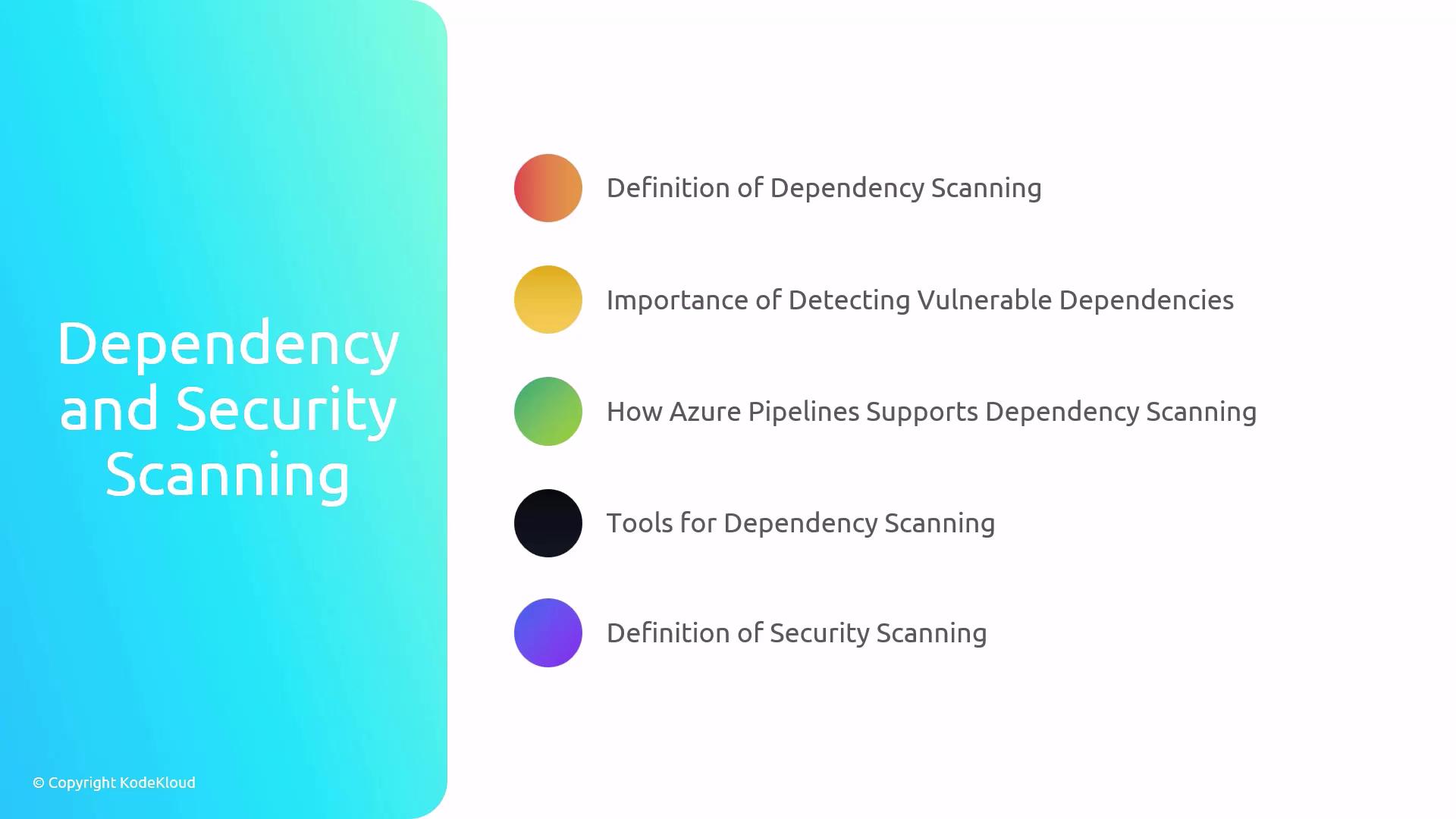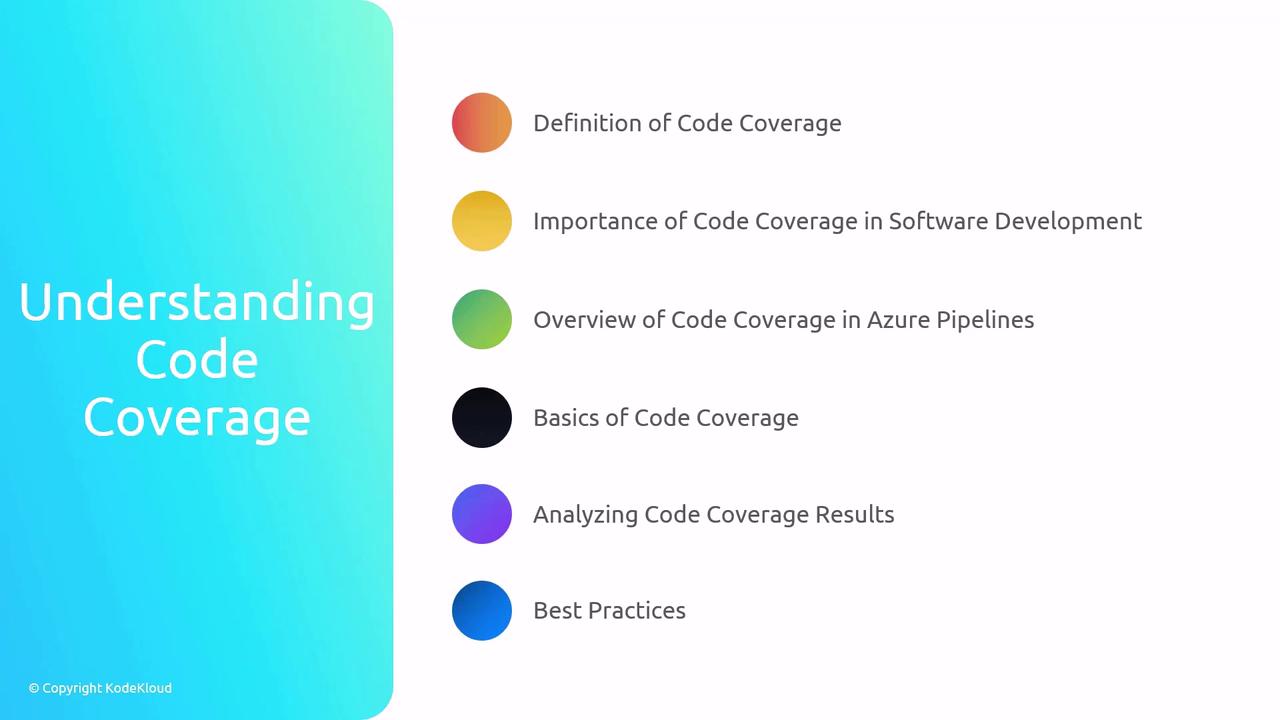AZ-400: Designing and Implementing Microsoft DevOps Solutions
Design and Implement Pipeline Automation
Summary
This article explores critical practices for securing, testing, and maintaining your software projects. We cover:
- Dependency Scanning
- Security Scanning
- Continuous Integration (CI) & Continuous Deployment (CD)
- Code Coverage
Dependency and Security Scanning
Dependency and security scanning are essential to catch vulnerabilities before they reach production. By integrating these scans into your CI/CD pipeline, you ensure a proactive defense against potential risks.
What Is Dependency Scanning?
Dependency scanning identifies known vulnerabilities in your project’s libraries and packages.
- Detect outdated or insecure dependencies
- Automate scans in Azure Pipelines
- Stop builds on critical findings
What Is Security Scanning?
Security scanning reviews your source code and configuration for common security flaws.
- Analyze code for injection, misconfigurations, and secrets
- Integrate with pull requests for immediate feedback
Note
Running scans early in your development cycle helps prevent remediation costs later in production.
Popular Tools
| Tool | Scan Type | Integration Example |
|---|---|---|
| GitHub Dependabot | Dependency | Automatic PRs for outdated dependencies |
| Snyk | Dependency & Security | snyk test --all-projects |
| OWASP ZAP | Security | docker run owasp/zap2docker-stable zap-baseline.py |
| Trivy | Container & Files | trivy filesystem --security-checks vuln,path . |

Continuous Integration (CI) & Continuous Deployment (CD)
Automated integration and deployment pipelines accelerate delivery while maintaining high quality.
CI/CD Definitions
- Continuous Integration (CI): Automatically build and test code on each commit.
- Continuous Deployment (CD): Automatically deploy tested code to staging or production.
Testing Strategies in Pipelines
| Test Type | Purpose | Example Command |
|---|---|---|
| Local Tests | Fast feedback, no external dependencies | npm test -- --watch |
| Unit Tests | Validate individual functions or classes | pytest tests/unit |
| Integration Tests | Validate interactions between components | pytest tests/integration |
| Load Tests | Measure performance under high traffic | k6 run load-test-script.js |
In Azure Pipelines, you can define multiple stages:
stages:
- stage: Build
jobs:
- job: Compile
steps:
- script: dotnet build
- stage: Test
dependsOn: Build
jobs:
- job: UnitTests
steps:
- script: dotnet test --logger trx
- job: IntegrationTests
steps:
- script: dotnet test --filter Category=Integration
- stage: Deploy
dependsOn: Test
jobs:
- job: Release
steps:
- script: az webapp deploy --name myApp --resource-group myRG
Warning
Always fail the pipeline on test failures to prevent unverified code from progressing.
Code Coverage
Code coverage measures how much of your source code is exercised by tests. It helps you identify untested areas and improves software quality.
Why Code Coverage Matters
- Visibility: Shows untested code paths
- Quality: Encourages writing meaningful tests
- Metrics: Helps track testing progress over time
Coverage Types
| Coverage Type | Description |
|---|---|
| Statement | Percentage of executed statements |
| Branch | Coverage of all possible code branches (if/else) |
| Path | All possible execution paths (rarely used) |
Integrating Coverage in Azure Pipelines
- task: DotNetCoreCLI@2
displayName: 'Run tests with coverage'
inputs:
command: test
projects: '**/*Tests/*.csproj'
arguments: '--collect:"XPlat Code Coverage"'
- task: PublishCodeCoverageResults@1
inputs:
codeCoverageTool: Cobertura
summaryFileLocation: '$(Agent.TempDirectory)/**/coverage.cobertura.xml'
Interpret coverage reports to guide your testing efforts:
- Focus on critical modules with low coverage
- Increase branch and path coverage for complex logic
- Set realistic coverage targets (e.g., 80–90%)

Links and References
Watch Video
Watch video content